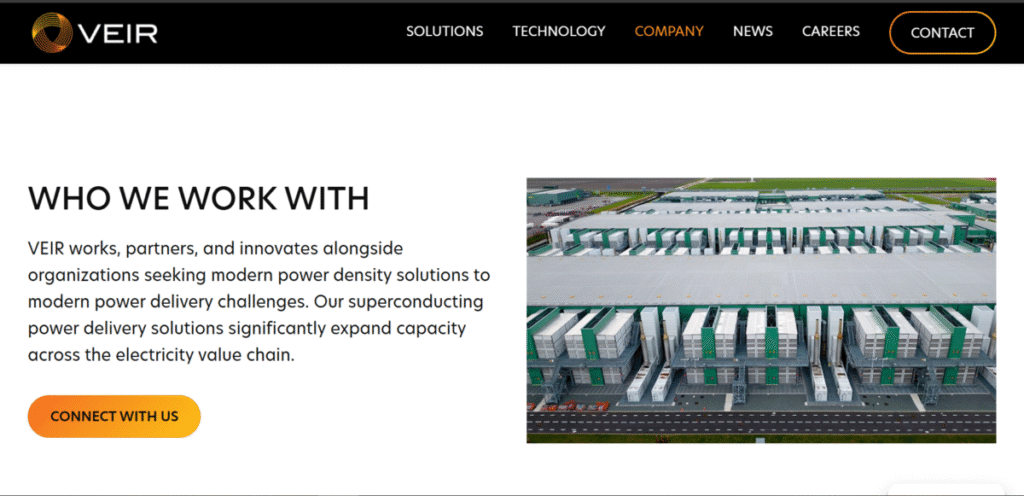Data centers are growing fast; in just a few years, the average power demand per server rack has risen from tens of kilowatts to more than 200 kW.
Industry experts expect this figure to reach 600 kW soon, and eventually one megawatt per rack.
This rapid growth has created a serious challenge. Traditional copper cables, which supply power to racks, are running out of capacity.
They take up too much space and produce too much heat.
As a result, operators are struggling to design new facilities that can meet the power and cooling needs of modern computing systems.
To address this problem, TechCrunch reported that VEIR, a Massachusetts-based startup backed by Microsoft, is introducing superconducting cables to data centers.
The company believes this technology can change how power is delivered inside these energy-hungry facilities.
Also read: Are AI Data Centers a Growing Strain on the U.S. Power Grid?
VEIR’s Superconducting

VEIR’s technology was originally designed for power transmission lines. However, utilities have been slow to adopt it.
Seeing the urgent needs in data centers, VEIR adapted its system for indoor, low-voltage environments.
The company’s first product is a cable system capable of delivering 3 megawatts of low-voltage electricity.
It combines superconducting materials with advanced cooling technology to move large amounts of power safely and efficiently.
To demonstrate the concept, VEIR built a simulated data center near its headquarters in Massachusetts.
The company plans to begin pilot installations in working data centers in 2026, with a commercial rollout expected in 2027.
Superconducting Cables
Superconductors are materials that can carry electricity with zero resistance when cooled below a certain temperature.
VEIR uses liquid nitrogen to keep its cables at –196 °C (–321 °F). At that temperature, electricity flows freely without energy loss.
Each VEIR cable includes a protective jacket that holds the coolant in place.
At both ends, termination boxes convert the superconducting line back to copper so it can connect with standard data-center hardware.
This setup makes superconducting cables deliver more power through a much smaller channel.
VEIR says its system requires 20 times less space than copper cables while carrying power five times farther.
Data Centers
VEIR’s leadership recognized a faster path to adoption in the data-center industry.
While utilities move slowly, data centers are expanding rapidly to meet the demands of AI, cloud computing, and digital services.
“The pace at which the data center community is moving, evolving, and scaling is far higher than the transmission community,” said Tim Heidel, VEIR’s chief executive officer.
As data-center developers search for ways to handle growing power density, superconducting systems showcase an immediate solution.
They reduce heat, free up space, and make it possible to add more computing capacity within the same footprint.
Benefits of VEIR’s System
1. Efficient Power Delivery
Traditional cables waste energy as heat but VEIR’s superconducting cables counter that loss through supercooling.
2. Space Optimization
Because the new cables are thinner, they require less physical space. This allows operators to install more servers per room for better computing capacity.
3. Improved Reliability
Lower heat generation means fewer thermal management problems. Equipment runs more consistently and has reduced maintenance and downtime.
4. Long-Term Scalability
As rack-level power consumption rises, VEIR’s system can scale without major redesigns. This future-proof approach could become critical as AI workloads continue to grow.
Roadmap
VEIR completed its first large-scale demonstration in 2025. The company expects pilot projects in 2026, followed by commercial availability in 2027.
However, there are still challenges; cryogenic systems require constant monitoring, and liquid nitrogen must be stored and circulated safely.
Also, installation costs may also be higher than traditional cabling. Despite these challenges, industry experts see promise.
Data centers face increasing pressure to handle more power while controlling energy use. A cable that delivers more electricity in less space could make a significant difference.
Implications
If superconducting cables prove reliable in commercial settings, they could eventually upgrade large-scale electricity distribution.
More efficient power transmission could benefit renewable-energy grids, electric-vehicle infrastructure, and high-performance computing facilities.
VEIR’s superconducting system is at the forefront of this search for efficiency.
As Heidel explained, “The AI and data center community is desperate to find solutions today and to stay ahead. There’s tremendous pressure to lead, not follow.”

